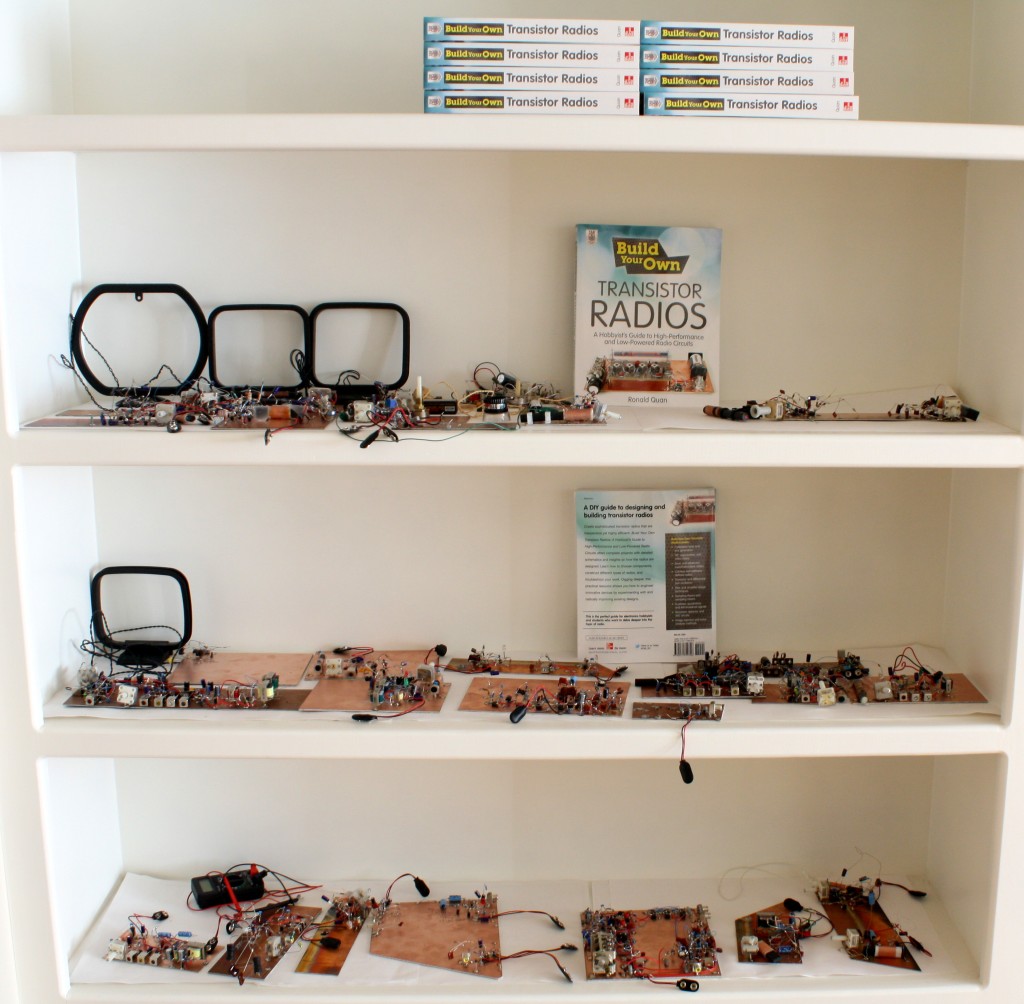Podcast: Play in new window | Download
Subscribe: Apple Podcasts | RSS
Click the above image for the full resolution photo of all the board Ron built for the book!

Welcome, Ron Quan! He is an engineer and the author of Build Your Own Transistor Radios: A Hobbyist’s Guide to High-Performance and Low-Powered Radio Circuits.
- Ron got his start working for radio stations: KNEW in Oakland (now in SF) (AM) and KALX at Berkeley (FM)
- Prior to that, he grew up playing with #6 ignition battery (dry cell) which is similar to a D cell.
- But that’s not all, he also built crystal radios (poly varicom) and tube radios (5 tube superhet)
- Once he entered industry, it was working on video at Ampex
- Later he worked at Sony
- Video has a lot of great signal processing problems and challenges. For example, they would sometimes have a 4 mhz bw signal with only a 5-10Mhz carrier!
- His first patent was of linearity compensation on B&W CRT TVs at Ampex. However, he has lots of patents to his name!
- Dave asked if it was true about Japanese manufacturers removing caps until the products just work; Ron used to put them every other chip, depending on distance between them.
- Howard Sam’s photofacts is a place to get schematics.
- They often had to make their own op amps, using parts like CA3086, CA3054, CA3127
- Analog video compensation was done with banks of varacter diodes.
- While he couldn’t talk about protection schemes, he did talk about (analog) scrambling of audio and video signals.
- They would move signals by pseudo random frequency shifting; this is different from the simpler and more common sync suppression method.
- Sync suppression could be easily defeated back then, either by DIY solutions or by black market boxes.
- Ron went and had to reverse engineer the reverse engineering of some of these boxes coming out of Brazil and Argentina
- The Analog Aficionados dinner, hosted by Paul Rako and sponsored by various companies, was last Saturday. Ron and various other high profile analog gurus were there.
- Ron published and presented two AES papers which have caused a little bit of a stir; he suggests new ways to measure frequency and develop standards.
- He’s not an audiophile (in the negative sense of the word) but he has worked for Monster Cable in the past!
- The old ways of measuring don’t tell the whole picture, such as THD and intermodulation distortion and freq response
- Newer methods are CCIF twintone signal (18 & 19 kHz), Transient Intermodulation Distortion or TIM test (square and sine wave) and frequency modulation distortion.
- The book was released a few months ago and has gotten great feedback so far!
- Chris likes that it gives context and builds to do up front.
- The whole thing was done in 26 weeks, including over 25 prototype boards! (see top picture)
- We all agreed that this book would be a good fit for a prototyping class.
Thanks to Ron for being on the show! We thought this was one of the most technically dense shows we’ve had yet, with tons of great industry history and fun stories from throughout Ron’s career.


I think there might be a gap in the audio around 24:53.
I downloaded it on a different computer and didn’t hear it. What was said right before the gap? That would help us find it. Thanks!
Dave: “Implement every single one of those in some way shape or form. It’s incredible”
Gap
Dave :”Hmmm. Yea that’s trivial.”
Yup, I know what that was. I hit mute on my end to fix something that had just kicked on and it cut Ron out too. Normally it doesn’t work like that but I did it different that time. Sorry!
Great interview. (One of your best!) I enjoyed the history and technical knowledge of Ron. I’ll have to buy his book.
Keep bringing in interesting guests!!
There was a gap in the audio as @Evan noted.
Another great podcast guys, we all like professionals with whom we can relate to or just find interesting. In my case if a guest immersed themselves in electronics at a young age, especially in the area of radio/TV, worked in a TV repair shop or in a radio station as an Engineer, I’m all ears. Ron’s book was recommended by a fellow Ham, so I had to buy it after this interview – can’t wait to receive it.
I received my first marketing email ever from Keithley today, WTF! Chris, did you work on the 2110 DMM? It’s probably out of my price range for personal use, but it looks awesome.
Ha, nope, not me! I worked on scientific stuff. I’ve noticed more of their marketing stuff too (Twitter, etc). They must have turned it up a notch. Bleck.
Great show lads. Just ordered the book. Thanks a lot!
Found TIM test of Valve amp and integrated amp. Worth checking out…
http://www.leonaudio.com.au/3-4.ratio.distortion.measurement.pdf
Heard you guys on Science360 channel. Came to theamphour after that and then found this which is
just the type of book I was looking for. Can’t wait to receive it so I can start building all the circuits.
Thanks guys.
Hey Newell! I think you might be one of the first to find us that way. Glad to hear that our being included has helped. Welcome and enjoy that book!